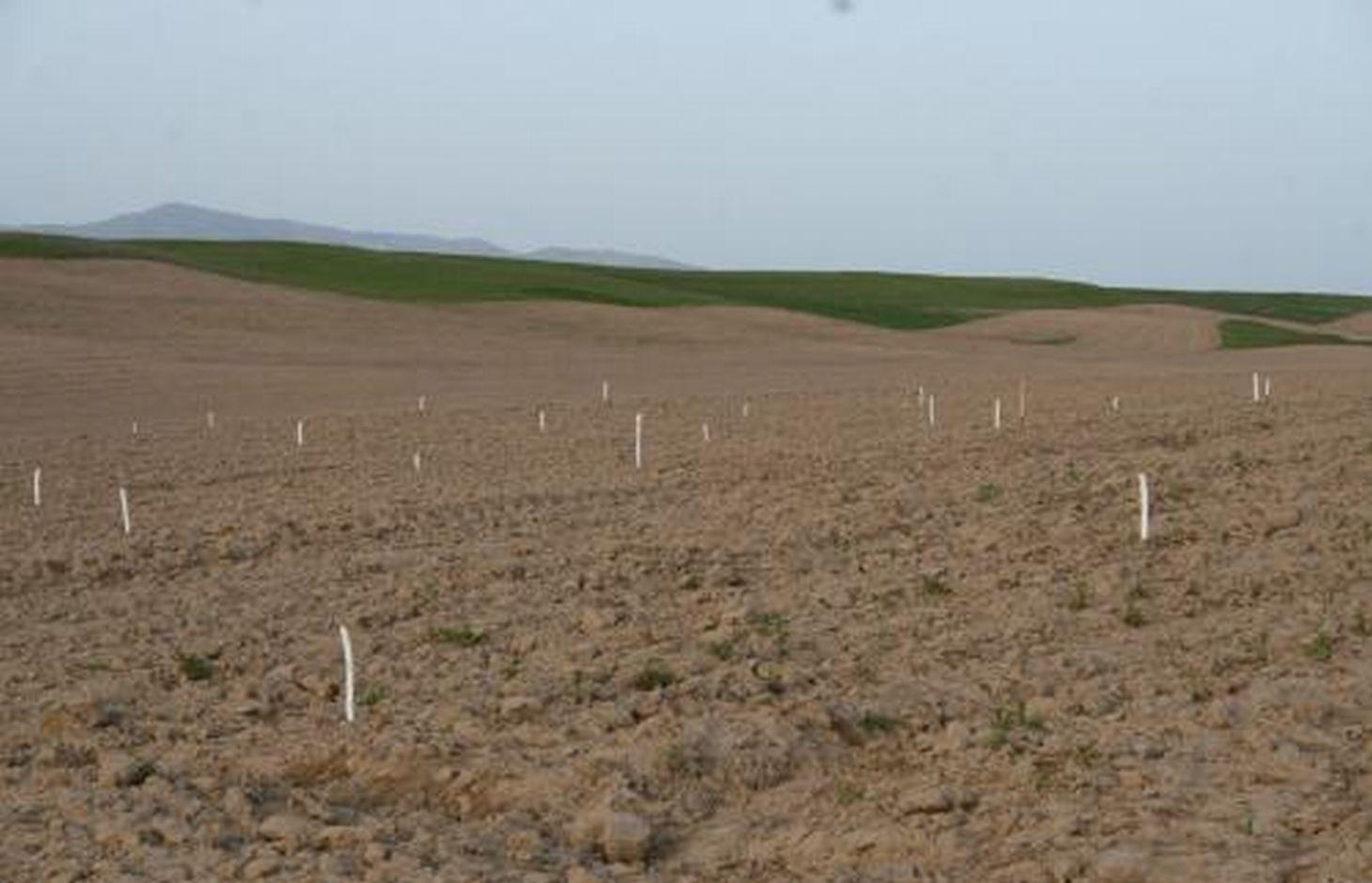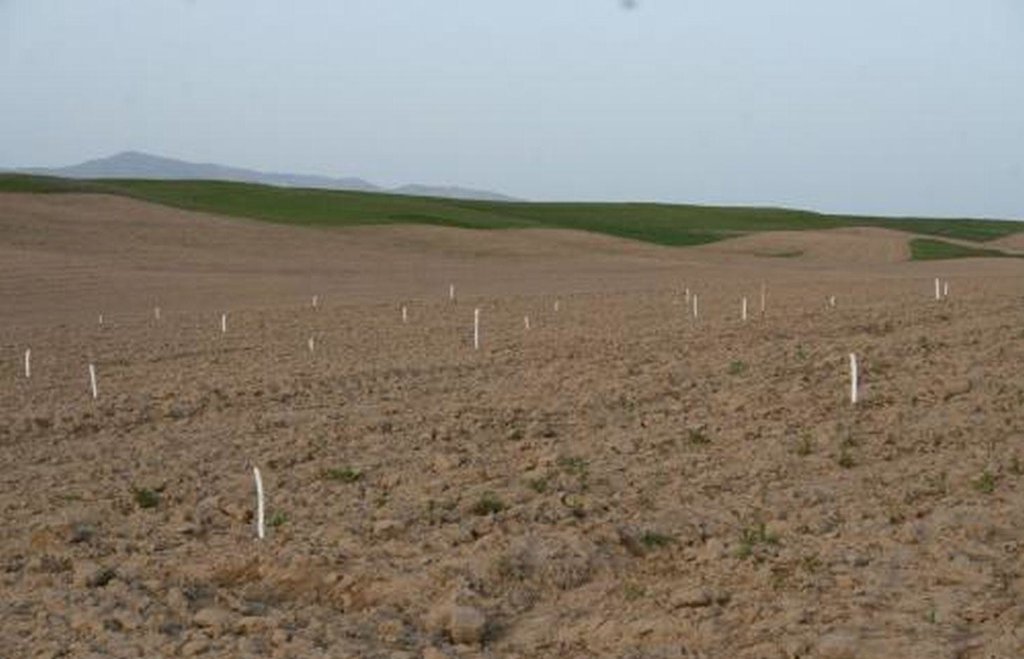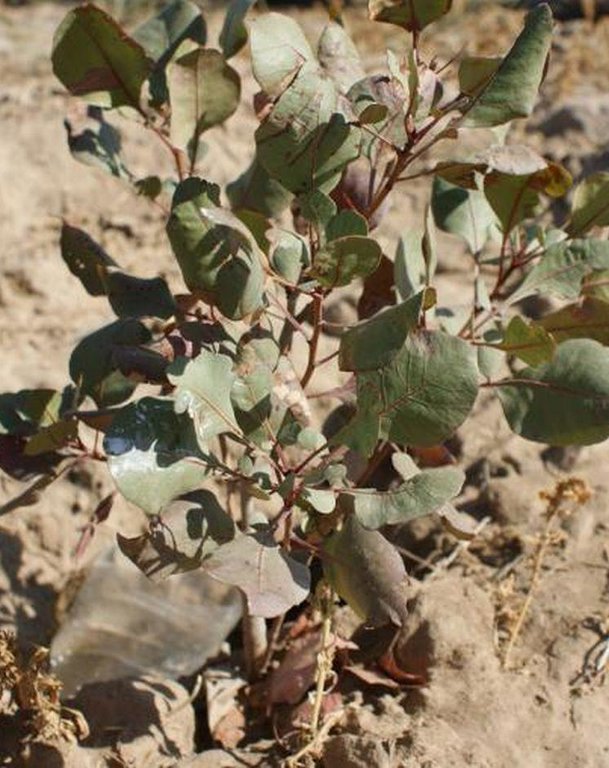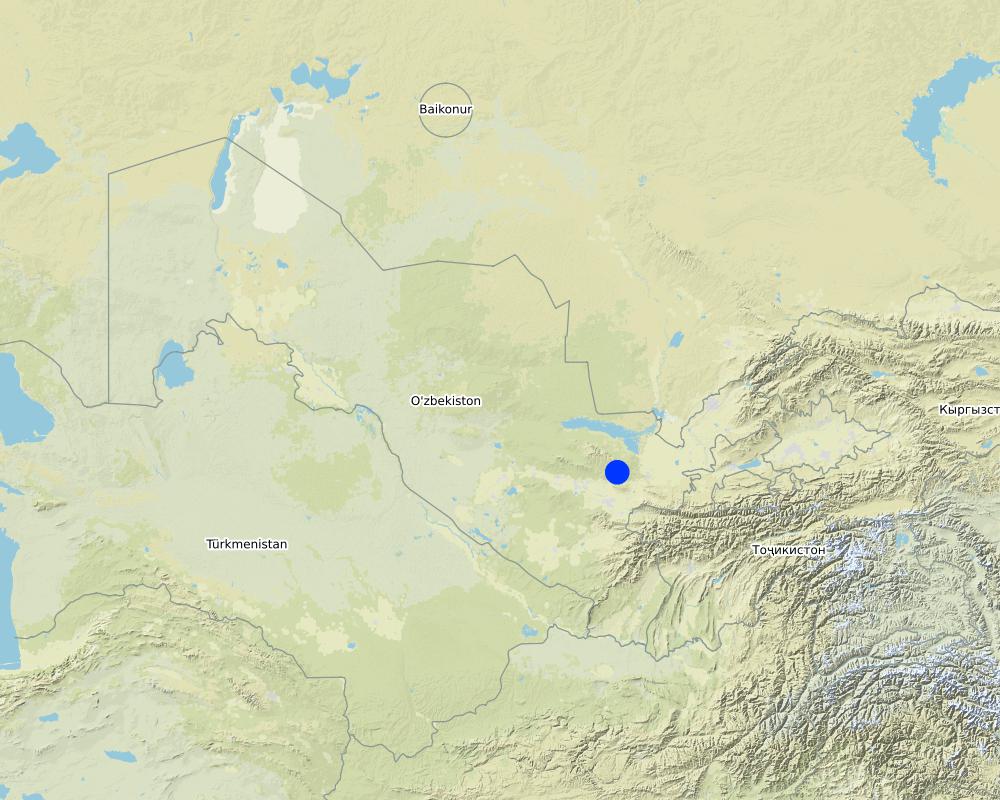Improvement of land under arid conditions through the creation of pistachio plantations (CACILM) [Uzbekistan]
- Creation:
- Update:
- Compiler: Rustam Ibragimov
- Editor: –
- Reviewers: Alexandra Gavilano, Fabian Ottiger, Rima Mekdaschi Studer
Central Asian Countries Initiative for Land Resource Management (CACILM)
technologies_1116 - Uzbekistan
- Full summary as PDF
- Full summary as PDF for print
- Full summary in the browser
- Full summary (unformatted)
- Improvement of land under arid conditions through the creation of pistachio plantations (CACILM): Aug. 22, 2019 (inactive)
- Improvement of land under arid conditions through the creation of pistachio plantations (CACILM): Nov. 25, 2019 (public)
- Improvement of land under arid conditions through the creation of pistachio plantations (CACILM): Aug. 1, 2017 (inactive)
- Improvement of land under arid conditions through the creation of pistachio plantations (CACILM): June 3, 2017 (inactive)
- Improvement of land under arid conditions through the creation of pistachio plantations (CACILM): Dec. 28, 2016 (inactive)
View sections
Expand all Collapse all1. General information
1.2 Contact details of resource persons and institutions involved in the assessment and documentation of the Technology
Key resource person(s)
SLM specialist:
Aleksey Volkov
UNDP
Uzbekistan
1.3 Conditions regarding the use of data documented through WOCAT
The compiler and key resource person(s) accept the conditions regarding the use of data documented through WOCAT:
Yes
1.5 Reference to Questionnaire(s) on SLM Approaches (documented using WOCAT)
2. Description of the SLM Technology
2.1 Short description of the Technology
Definition of the Technology:
This technology is aimed at the creation of pistachio plantations on gentle slopes to improve the land’s productivity and to rehabilitate the arid land in the hill zone.
2.2 Detailed description of the Technology
Description:
Adyr (hilly) lands occupy around 400,000 ha of the territory of Uzbekistan. Increasing anthropogenic stress and unsustainable land use practices put these lands on the verge of desertification. Currently, the foothills are mostly used as pastures and as rain-fed cropland for growing mainly winter wheat. Due to the low amount of precipitation, the production of rain-fed wheat is unsustainable and rarely exceeds 8-10 centners/ha (usually 3-5 centners/ha), which sometimes is not enough to compensate for the cost of seed grain. Pastures become compacted due to overgrazing. Rehabilitating lands in the foothill zone and ensuring their sustainable use in the future requires alternative production methods. The creation of tree plantations with multi-effect features would ensure both ecological and material benefits for the local population (in the frame of CACILM).
Purpose of the Technology: The purpose of this technology is the restoration of landscapes in the foothill and arid hill zone, adaptation to climate change and an increase in agricultural productivity and income.
Establishment / maintenance activities and inputs: The purpose of this technology is the restoration of landscapes in the foothill and arid hill zone, adaptation to climate change and an increase in agricultural productivity and income.
The technology is based on the use of the biological trait of pistachios, which enables the tree to grow in exceptionally dry conditions without irrigation. Planting is organized in the traditional way, beginning with soil preparation, which includes tilling & sub-soiling the field. Planting is preceded by the marking of the plot with pegs denoting the planting spots in accordance with a 6х8 meter layout (planting density is 208 pcs/ha). To prevent animal grazing, the plantation is fenced with barbed wire on wooden poles & the planting of briar. In 2-3 years, the briar becomes a live fence, & barbed wire can be re-used in other plots.
Post-planting watering is performed at a rate of 1,5-2 liters / plant. During the three months of summer, irrigation is performed 3-5 times a month using a simple drip technique using plastic bottles. For rain-fed areas partially provided with water (300-500 mm/year), irrigation is performed only for the first two years. Until the pistachio enters the productive yield phase (the first 8 years), the inter-row space of the plantation is used for growing tilled drought-resistant crops such as safflower, peas, melons, gourds & alfalfa. Alfalfa is especially important for improving soil properties (structure- & organic matter formation, nitrogen fixation, etc.). The technology requires no additional start-up investments, since soil preparation was already performed during creation of the pistachio plantation.
Mineral fertilizers are applied: 290 kg/ha of ammonium nitrate (N 33-34,5%) & 220 kg/ha of superphosphate (P 45%). Grafting with the selected variety is performed 3-4 years after planting in order to stimulate early fructification
Natural / human environment: The local population used to lack additional revenue sources outside of livestock production. Pistachio plantations are of exceptional importance for people living in the areas where almost no other fruit bearing species would grow without supplementary irrigation. In the long run, pistachio production is much more profitable than livestock production, as well as more environment-friendly. The average productivity of pistachio is around 10 centners/ha and the lifespan is more than 1000 years. Briar planted along the fence bears fruit for 20-25 years, which is a supplementary source of income. Crops planted in the inter-row space partially compensate for the initial investment in the technology and improve the soil.
2.3 Photos of the Technology
2.5 Country/ region/ locations where the Technology has been applied and which are covered by this assessment
Country:
Uzbekistan
Region/ State/ Province:
Uzbekistan/Djizak oblast
Further specification of location:
Farish district
Specify the spread of the Technology:
- evenly spread over an area
If precise area is not known, indicate approximate area covered:
- < 0.1 km2 (10 ha)
Comments:
Total area covered by the SLM Technology is 0.42 Km2.
The pistachio plantation is located on a flat slope in a hilly area of sub mountains (adyr) with a low precipitation rate and lack of surface water for irrigation. Before, it was a pasture with clear signs of erosion.
Map
×2.6 Date of implementation
If precise year is not known, indicate approximate date:
- less than 10 years ago (recently)
2.7 Introduction of the Technology
Specify how the Technology was introduced:
- through projects/ external interventions
Comments (type of project, etc.):
Introduced in 2009 within the framework of the GEF Small Grants Programme.
3. Classification of the SLM Technology
3.2 Current land use type(s) where the Technology is applied
Land use mixed within the same land unit:
Yes
Specify mixed land use (crops/ grazing/ trees):
- Agro-pastoralism (incl. integrated crop-livestock)

Cropland
- Annual cropping
- Perennial (non-woody) cropping
- Tree and shrub cropping
Annual cropping - Specify crops:
- fodder crops - alfalfa
Tree and shrub cropping - Specify crops:
- tree nuts (brazil nuts, pistachio, walnuts, almonds, etc.)
Number of growing seasons per year:
- 1
Specify:
Longest growing period in days: 220Longest growing period from month to month: October-June winter wheatSecond longest growing period in days: 110Second longest growing period from month to month: March - June natural pasture vegetation
Is intercropping practiced?
Yes

Grazing land

Forest/ woodlands
Comments:
Low water availability, non-uniform precipitation, both in time and season (maximum during the autumn-winter-spring period) and lack of surface water sources for land irrigation.
Major land use problems (land users’ perception): Weather conditions
Semi-nomadism / pastoralism: Small ruminants, sheep and goats, are dominant
Grazingland comments: The lack of pasture rotation, pasture sequencing, and the dominant number of sheep and goats in the herds facilitate pasture degradation.
Future (final) land use (after implementation of SLM Technology): Mixed: Mf: Agroforestry
Type of cropping system and major crops comments: Land in the foothills zone (adyrs) in Uzbekistan is used as rain-fed cropland for the cultivation of grain crops as well as for pastures. The productivity of grain crops is low and unstable due to insufficient precipitation, and in some years, there is no yield at all. Due to overgrazing, the pastures are degraded and show low productivity.
Livestock is grazing on crop residues
Type of grazing system comments: The lack of pasture rotation, pasture sequencing, and the dominant number of sheep and goats in the herds facilitate pasture degradation.
3.3 Has land use changed due to the implementation of the Technology?
Has land use changed due to the implementation of the Technology?
- Yes (Please fill out the questions below with regard to the land use before implementation of the Technology)
Land use mixed within the same land unit:
Yes
Specify mixed land use (crops/ grazing/ trees):
- Agroforestry
Comments:
Type of cropping system and major crops comments: Land in the foothills zone (adyrs) in Uzbekistan is used as rain-fed cropland for the cultivation of grain crops as well as for pastures. The productivity of grain crops is low and unstable due to insufficient precipitation, and in some years, there is no yield at all. Due to overgrazing, the pastures are degraded and show low productivity.
Livestock is grazing on crop residues
Type of grazing system comments: The lack of pasture rotation, pasture sequencing, and the dominant number of sheep and goats in the herds facilitate pasture degradation.
3.4 Water supply
Water supply for the land on which the Technology is applied:
- rainfed
Comments:
Водопотребление: богарное, богарное
3.6 SLM measures comprising the Technology

agronomic measures
- A1: Vegetation/ soil cover
- A2: Organic matter/ soil fertility
- A3: Soil surface treatment

vegetative measures
- V1: Tree and shrub cover

management measures
- M1: Change of land use type
Comments:
Основные мероприятия: связанные с использованием растительности, управленческие
Второстепенные мероприятия: агрономические
Тип агрономических мероприятий: смешанное возделывание / междурядное возделывание, минеральные (неорганические) удобрения
Тип мероприятий, связанных с использованием растительности: урегулированный: -линейный
3.7 Main types of land degradation addressed by the Technology

soil erosion by water
- Wt: loss of topsoil/ surface erosion

soil erosion by wind
- Et: loss of topsoil

chemical soil deterioration
- Cn: fertility decline and reduced organic matter content (not caused by erosion)

biological degradation
- Bq: quantity/ biomass decline
Comments:
Main causes of degradation: overgrazing (unsustainable grazing), droughts (low precipitation), population pressure (overgrazing, excess load on the pastures)
3.8 Prevention, reduction, or restoration of land degradation
Specify the goal of the Technology with regard to land degradation:
- reduce land degradation
Comments:
Основная цель: предотвращение / сокращение деградации
4. Technical specifications, implementation activities, inputs, and costs
4.1 Technical drawing of the Technology
Technical specifications (related to technical drawing):
Planting of pistachio on a slope according to a 6 х 8 meter layout, plantation is protected with a ditch, barbed wire and a row of briar
Location: Norvon v. Farming enterprise “SBM Mukhammadamin”. Farish district/Djizak oblast
Date: 10-09-2011
Technical knowledge required for field staff / advisors: moderate
Technical knowledge required for land users: moderate
Main technical functions: improvement of ground cover, increase in organic matter, increase in nutrient availability (supply, recycling,…), improvement of soil fertility (with crop rotation incl. Beans+lucerne)
Mixed cropping / intercropping
Material/ species: Pistachio
Quantity/ density: 208 tr/ha
Remarks: with alfalfa in between the rows
Mineral (inorganic) fertilizers
Material/ species: ammonium nitrate
Quantity/ density: 290 kg/ha
Remarks: superphosphate, 220 kg/ha
Aligned: -linear
Vegetative material: C : perennial crops
Number of plants per (ha): 208
Vertical interval between rows / strips / blocks (m): 0.02
Vertical interval within rows / strips / blocks (m): 8
Width within rows / strips / blocks (m): 6
Perennial crops species: Alfalfa seeded
Other species: pistachio nut tree species
Slope (which determines the spacing indicated above): 16%
Change of land use type
Author:
R.Ibragimov, UZGIP Institute, 44, Navoi Str., Tashkent, Uzbekistan
4.2 General information regarding the calculation of inputs and costs
other/ national currency (specify):
Uzbek sum
If relevant, indicate exchange rate from USD to local currency (e.g. 1 USD = 79.9 Brazilian Real): 1 USD =:
1430.0
Indicate average wage cost of hired labour per day:
10.00
4.3 Establishment activities
| Activity | Timing (season) | |
|---|---|---|
| 1. | Tillage | Autumn |
| 2. | Cultivation | Autumn |
| 3. | Planting pistachio | March-April |
| 4. | Fence of barbed wire and briarfence installation | March-April |
4.4 Costs and inputs needed for establishment
| Specify input | Unit | Quantity | Costs per Unit | Total costs per input | % of costs borne by land users | |
|---|---|---|---|---|---|---|
| Labour | Fencing | man/days | 14.0 | 7.04 | 98.56 | 100.0 |
| Labour | Planting pistachio | man/days | 8.0 | 5.6 | 44.8 | |
| Equipment | Tractor and cultivator for cultivation | ha | 1.0 | 14.5 | 14.5 | 100.0 |
| Equipment | Tractor and plough for tillage | ha | 1.0 | 36.4 | 36.4 | 100.0 |
| Plant material | Seedlings (208 per ha) | ha | 1.0 | 145.5 | 145.5 | |
| Construction material | Wire | kg | 144.0 | 3.89 | 560.16 | 100.0 |
| Construction material | Poles | Pieces | 200.0 | 1.3608 | 272.16 | 100.0 |
| Construction material | Briar plantlets | Pieces | 400.0 | 0.07 | 28.0 | 100.0 |
| Other | Transportation | Times | 1.0 | 30.76 | 30.76 | 100.0 |
| Total costs for establishment of the Technology | 1230.84 | |||||
| Total costs for establishment of the Technology in USD | 0.86 | |||||
Comments:
Duration of establishment phase: 3 month(s)
4.5 Maintenance/ recurrent activities
| Activity | Timing/ frequency | |
|---|---|---|
| 1. | Sowing alfalfa and applyingthe fertilizers | March-April |
| 2. | Mowing | |
| 3. | Irrigation | Spring, summer, autumn |
| 4. | Fertilizer application | Spring |
| 5. | Weeding | Spring, summer, autumn |
| 6. | Ingrafting | At year 3-4 |
4.6 Costs and inputs needed for maintenance/ recurrent activities (per year)
| Specify input | Unit | Quantity | Costs per Unit | Total costs per input | % of costs borne by land users | |
|---|---|---|---|---|---|---|
| Labour | Fertilizer application | man/days | 1.0 | 7.0 | 7.0 | 100.0 |
| Labour | Irrigation | man/days | 5.0 | 7.0 | 35.0 | 100.0 |
| Labour | Weeding | man/days | 270.0 | 7.0 | 1890.0 | 100.0 |
| Labour | Ingrafting | man/days | 10.0 | 83.92 | 839.2 | 100.0 |
| Equipment | Machine use for sowing | ha | 1.0 | 14.5 | 14.5 | 100.0 |
| Equipment | Machine use for mowing | ha | 1.0 | 27.9 | 27.9 | 100.0 |
| Equipment | Machine use for fertilizer application | ha | 1.0 | 7.0 | 7.0 | 100.0 |
| Plant material | Seeds | kg | 4.5 | 3.48888 | 15.7 | 100.0 |
| Fertilizers and biocides | Fertilizer (400kg/ha) | ha | 1.0 | 78.5 | 78.5 | 100.0 |
| Fertilizers and biocides | Fertilizer (510kg/ha) | ha | 1.0 | 106.9 | 106.9 | 100.0 |
| Other | Water delivery | Times | 5.0 | 17.48 | 87.4 | 100.0 |
| Total costs for maintenance of the Technology | 3109.1 | |||||
| Total costs for maintenance of the Technology in USD | 2.17 | |||||
Comments:
The values were calculated per 1 hectare (as of 2009). Due to economies of scale, increasing the area would reduce the cost per hectare of creating the plantation. The cost is minimal (45% of the total amount) when the plantation area is 20 ha. Running costs also decrease as the trees age. In 2 years, irrigation ceases and after 10 years, alfalfa is no longer grown in the inter-row space, as the pistachio commercial production phase starts.
4.7 Most important factors affecting the costs
Describe the most determinate factors affecting the costs:
The majority of the cost is associated with ingrafting with the selected variety. Management activities (fencing around the plantation to prevent animal access) also incurred significant expenditure. However, there are other types of fencing that probably are less expensive and may be used. Cost is affected by the distance between the farming enterprise and both the sources of irrigation water and the place of procurement of plantlets (transportation costs)
5. Natural and human environment
5.1 Climate
Annual rainfall
- < 250 mm
- 251-500 mm
- 501-750 mm
- 751-1,000 mm
- 1,001-1,500 mm
- 1,501-2,000 mm
- 2,001-3,000 mm
- 3,001-4,000 mm
- > 4,000 mm
Agro-climatic zone
- semi-arid
Thermal climate class: temperate. For 2 months the air temperature is <5оС and for 9 months it is above 10 оС
5.2 Topography
Slopes on average:
- flat (0-2%)
- gentle (3-5%)
- moderate (6-10%)
- rolling (11-15%)
- hilly (16-30%)
- steep (31-60%)
- very steep (>60%)
Landforms:
- plateau/plains
- ridges
- mountain slopes
- hill slopes
- footslopes
- valley floors
Altitudinal zone:
- 0-100 m a.s.l.
- 101-500 m a.s.l.
- 501-1,000 m a.s.l.
- 1,001-1,500 m a.s.l.
- 1,501-2,000 m a.s.l.
- 2,001-2,500 m a.s.l.
- 2,501-3,000 m a.s.l.
- 3,001-4,000 m a.s.l.
- > 4,000 m a.s.l.
5.3 Soils
Soil depth on average:
- very shallow (0-20 cm)
- shallow (21-50 cm)
- moderately deep (51-80 cm)
- deep (81-120 cm)
- very deep (> 120 cm)
Soil texture (topsoil):
- medium (loamy, silty)
Topsoil organic matter:
- low (<1%)
5.4 Water availability and quality
Ground water table:
> 50 m
Availability of surface water:
poor/ none
5.5 Biodiversity
Species diversity:
- low
5.6 Characteristics of land users applying the Technology
Market orientation of production system:
- mixed (subsistence/ commercial)
Off-farm income:
- less than 10% of all income
Individuals or groups:
- individual/ household
Level of mechanization:
- manual work
- mechanized/ motorized
Gender:
- men
Indicate other relevant characteristics of the land users:
Land users applying the Technology are mainly common / average land users
Population density: 10-50 persons/km2
Annual population growth: 1% - 2%
5.7 Average area of land used by land users applying the Technology
- < 0.5 ha
- 0.5-1 ha
- 1-2 ha
- 2-5 ha
- 5-15 ha
- 15-50 ha
- 50-100 ha
- 100-500 ha
- 500-1,000 ha
- 1,000-10,000 ha
- > 10,000 ha
Is this considered small-, medium- or large-scale (referring to local context)?
- medium-scale
Comments:
Average area of land owned or leased by land users applying the Technology: 5-15 ha, 15-50 ha, 50-100 ha, 50-100 ha
5.8 Land ownership, land use rights, and water use rights
Land ownership:
- state
Land use rights:
- leased
Comments:
Farmers’ ownership of the land is based on long-term leases (50 years) without the right of sale or inheritance. In the dekhkan households (up to 2 hectares), the land is privately owned.
5.9 Access to services and infrastructure
health:
- poor
- moderate
- good
education:
- poor
- moderate
- good
technical assistance:
- poor
- moderate
- good
employment (e.g. off-farm):
- poor
- moderate
- good
markets:
- poor
- moderate
- good
energy:
- poor
- moderate
- good
roads and transport:
- poor
- moderate
- good
drinking water and sanitation:
- poor
- moderate
- good
financial services:
- poor
- moderate
- good
6. Impacts and concluding statements
6.1 On-site impacts the Technology has shown
Socio-economic impacts
Production
risk of production failure
product diversity
Income and costs
farm income
diversity of income sources
Socio-cultural impacts
food security/ self-sufficiency
health situation
Ecological impacts
Soil
soil cover
soil loss
nutrient cycling/ recharge
soil organic matter/ below ground C
Biodiversity: vegetation, animals
biomass/ above ground C
6.2 Off-site impacts the Technology has shown
A reduction in atmospheric СО2
Comments/ specify:
levels through sequestration in the tree plantation biomass contributes towards the common efforts aimed at combating global warming
Improved food diversity
Comments/ specify:
Improved food diversity
6.3 Exposure and sensitivity of the Technology to gradual climate change and climate-related extremes/ disasters (as perceived by land users)
Gradual climate change
Gradual climate change
| Season | increase or decrease | How does the Technology cope with it? | |
|---|---|---|---|
| annual temperature | increase | well |
Climate-related extremes (disasters)
Meteorological disasters
| How does the Technology cope with it? | |
|---|---|
| local rainstorm | well |
| local windstorm | well |
Climatological disasters
| How does the Technology cope with it? | |
|---|---|
| drought | well |
Hydrological disasters
| How does the Technology cope with it? | |
|---|---|
| general (river) flood | not well |
Other climate-related consequences
Other climate-related consequences
| How does the Technology cope with it? | |
|---|---|
| reduced growing period | well |
Comments:
Pistachio is a highly drought-resistant species, able to successfully grow and produce high quality yields in arid conditions where other species cannot grow without artificial irrigation.
6.4 Cost-benefit analysis
How do the benefits compare with the establishment costs (from land users’ perspective)?
Short-term returns:
positive
Long-term returns:
very positive
How do the benefits compare with the maintenance/ recurrent costs (from land users' perspective)?
Short-term returns:
positive
Long-term returns:
very positive
Comments:
Lack of quick income generation from growing pistachio is compensated by the cultivation of tilled drought resistant crops in the inter-row space, including safflower, peas, melons, gourds and alfalfa.
6.5 Adoption of the Technology
Comments:
100% of land user families have adopted the Technology with external material support
1 land user families have adopted the Technology with external material support
There is no trend towards spontaneous adoption of the Technology
Comments on adoption trend: Limited financial capacity prevents farmers from investing in long-term projects. Possibly, long term investment is also affected by the fact that the land is rented rather than privately owned.
6.7 Strengths/ advantages/ opportunities of the Technology
| Strengths/ advantages/ opportunities in the land user’s view |
|---|
| Profitably high prices on the pistachio market |
| Strengths/ advantages/ opportunities in the compiler’s or other key resource person’s view |
|---|
|
Pistachio is the most financially promising crop suited for the arid conditions in the foothills of Uzbekistan; the return on investment of pistachio plantations is 500-600%. How can they be sustained / enhanced? The plantations starts generating stable income in its 5th year after engrafting |
|
Pistachio-based horticulture is a more acceptable form of land use compared with livestock production and rain-fed crop production from the point-of-view of the sustainability of Uzbekistan’s arid foothill ecosystems; How can they be sustained / enhanced? In order to attract farmers to the cultivation of pistachios, it is necessary to promote benefits of gardening over the unprofitable rainfed agriculture and pasture use |
|
Investment in pistachio plantations would generate income throughout the farmer’s life and the lives of his descendants. How can they be sustained / enhanced? The life span of a pistachio tree is more than 1000 years |
|
Additional local development factors (additional income, extra work places and other benefits). How can they be sustained / enhanced? Throughout the productive period of the pistachio plantation (1000 years) |
6.8 Weaknesses/ disadvantages/ risks of the Technology and ways of overcoming them
| Weaknesses/ disadvantages/ risks in the land user’s view | How can they be overcome? |
|---|---|
| Suffice expensive technology in the initial period (purchase of seedlings, irrigation difficulties due to lack of water sources) | Government assistance is needed |
| Not enough money to invest in long-term | State financial support is needed |
| Weaknesses/ disadvantages/ risks in the compiler’s or other key resource person’s view | How can they be overcome? |
|---|---|
| The most significant constraint is long period before profitability (up to 10 years) | To grown between the rows before row crops of fruiting pistachio |
| An insufficient economic level for the making of long-term investments aimed at profit generation | To provide micro-loans of farmers who wanted to do pistachio orchards or provide other forms of financial assistance |
7. References and links
7.1 Methods/ sources of information
7.2 References to available publications
Title, author, year, ISBN:
Норвон: от животноводства к лесоводству
Available from where? Costs?
http://www.sgp.uz/ru/zavershennie-proekti/139
Links and modules
Expand all Collapse allLinks
No links






